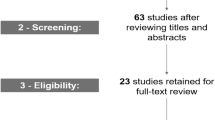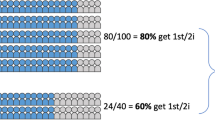Abstract
In introducing the special issue on Large Class Pedagogy: Opportunities and Challenges of Massification the present editorial takes stock of the emerging literature on this subject. We seek to contribute to the massificaiton debate by considering one result of it: large class teaching in higher education. Here we look to large classes as a problem in promoting student learning, quality education, and consequently as a challenge to socio-economic development. That said, whilst large classes do pose very specific challenges, they also hold promise and opportunities for innovation in support of student learning. Here we consider the contributions to this special issue from a cross section of disciplines and higher education environments.
Similar content being viewed by others
References
Altbach, P. G. (1992). Higher education, democracy and development: Implications for newly industrialized countries. Interchange, 23(1&2), 143–163.
Biggs, J. B. (1996). Enhancing teaching through constructive alignment. Higher Education, 32, 347–364.
Biggs, J. (1999). What the student does: Teaching for enhanced learning. Higher Education Research and Development, 18(1), 57–75.
Bloom, D., Canning, D., & Chan, K. (2005). Higher education and development in Africa. Washington, DC: World Bank. http://siteresources.worldbank.org/EDUCATION/Resources/278200-1099079877269/547664-1099079956815/HigherEd_Econ_Growth_Africa.pdf. Accessed 30 April 2013.
Bolton-Lewis, G. (1998). Applying the SOLO taxonomy to learning in higher education. In B. Dart & G. Boulton-Lewis (Eds.), Teaching and learning in higher education. Victoria: Australian Council for Educational Research.
Boud, D. (1982). Towards student responsibility for learning. In D. Boud (Ed.), Developing student autonomy in learning. London: Kogan Page.
Cooper, J. L., & Robinson, P. (2000). The argument for making large classes seem small. New Directives for Teaching and Learning, 81, 5–16.
Cuseo, J. (2007). The empirical case against large class size: Adverse effects on the teaching, learning, and retention of first-year students. Journal of Faculty Development, 21, 5–21.
Ehrenberg, R. G., Brewer, D. J., Gamoran, A., & Willms, J. D. (2001). Class size and student achievement. Psychological Science in the Public Interest, 2(1), 1–30.
Exeter, D. J., Ameratunga, S., Ratima, M., Morton, S., Dickson, M., Hsu, D., et al. (2010). Student engagement in very large classes: The teachers’ perspective. Studies in Higher Education, 35(7), 761–775.
Gibbons, M. (1998). Higher education relevance in the 21st Century. Association of Commonwealth Universities. http://ec.europa.eu/education/external-relation-programmes/doc/confbalkans/material/21stcentury_en.pdf. Accessed 14 Dec 2013.
Hornsby, D. J., Osman, R., & De Matos Ala, J. (2013). Teaching large classes: Interdisciplinary perspectives for quality tertiary education. Stellenbosch: SUN Media.
Kember, D. (1998). Teaching beliefs and their impacts on students’ approach to learning. In B. Dart & G. Boulton-Lewis (Eds). Teaching and learning in higher education. Victoria: ACER (Australian Council for Educational Research).
Marton, F., & Booth, S. (1997). Learning and awareness. New York: Lawrence Elbaum Associates Inc.
McKeachie, W. J. (1980). Class size, large classes and multiple sections. Academe, 66(1), 24–27.
Meyers, N., & Nulty, D. (2002). Assessment and student engagement. Learning communities and assessment cultures conference organised by the EARLI special interest group on assessment and evaluation, University of Northumbria, 28–30 August 2002. http://www.leeds.ac.uk/educol/documents/00002240.htm. Accessed 14 Dec 2013.
Mohamedbhai, G. (2008). The effects of massification on higher education in Africa. Report from the Working Group on Higher Education of the Association for the Development of Education in Africa. http://www2.aau.org/wghe/scm/meetings/mai08/adea/study_massification.pdf. Accessed 13 Jan 2014.
Mulryan-Kyne, C. (2010). Teaching large classes at college and university level: Challenges and opportunities. Teaching in Higher Education, 15(2), 175–185.
OECD (Organisation for Economic Co-operation and Development). (2008). Tertiary education for the knowledge society OECD—Thematic Review of Tertiary Education: Synthesis Report. http://www.oecd.org/dataoecd/20/4/40345176.pdf. Accessed 2 Dec 2013.
Powell, J. P. (1982). Moving towards independent learning. In D. Boud (Ed.), Developing student autonomy in learning. London: Kogan Page.
Ramsden, P. (1992). Learning to teach in higher education. London: Routledge.
Rowntree, D. (1987). Assessing students: How shall we know them?. London: Kogan Page.
Scott, P. (1995). The meanings of mass higher education. Buckingham: SHRE and Open University Press.
Trow, M. (2000). From mass higher education to universal access: The American advantage. UC Berkley: Research and Occasional Paper Series, Center for Studies in Higher Education.
Varghese, N. V. (2013). Governance reforms in higher education: A study of selected countries in Africa. UNESCO; International Institute for Educational Planning. IIEP/SEM334/Theme paper. http://www.iiep.unesco.org/fileadmin/user_upload/News_And_Events/pdf/2013/Governance_reforms_in_HE_paper_PF.pdf. Accessed 5 Feb 2014.
World Bank. (2002). Constructing knowledge societies: New challenges for tertiary education. Washington, DC: International Bank for Reconstruction and Development/The World Bank. http://siteresources.worldbank.org/INTAFRREGTOPTEIA/Resources/Constructing_Knowledge_Societies.pdf. Accessed 3 Dec 2013.
Author information
Authors and Affiliations
Corresponding author
Rights and permissions
About this article
Cite this article
Hornsby, D.J., Osman, R. Massification in higher education: large classes and student learning. High Educ 67, 711–719 (2014). https://doi.org/10.1007/s10734-014-9733-1
Published:
Issue Date:
DOI: https://doi.org/10.1007/s10734-014-9733-1




